Abstract
In addition to the challenges inherent in environmental health risk assessment, the study of reproductive health requires thorough consideration of the very definition of reproductive risk. Researchers have yet to determine which end points need to be considered to comprehensively evaluate a community's reproductive health. Several scientific issues should be considered in the selection of end points: the severity of the outcomes, with a trade-off between clinical severity and statistical or biological sensitivity; the relative sensitivity of different outcomes to environmental agents; the interrelationship among adverse outcomes; the baseline frequency of the adverse outcome; evidence from reproductive toxicology; and specificity of reproductive effects from the environmental agent. Simultaneously, practical concerns should be addressed: frequency of occurrence of an event and consequent statistical power to evaluate changes; frequency of prerequisites (e.g., pregnancy) that are necessary to be at risk; time and money resource requirements for measuring the outcome; amenability of the end point to retrospective measurement; and burden of measurement on the population being studied. In this article, we discuss these scientific and practical considerations and recommend that reproductive risk assessment include measures of fecundability (menstrual function, time to pregnancy), fetal loss (clinically recognized miscarriage), and infant health (birth weight, gestational age). Additional methodological research is needed to refine the array of reproductive health measures that need to be examined as a consequence of environmental exposures.
Full text
PDF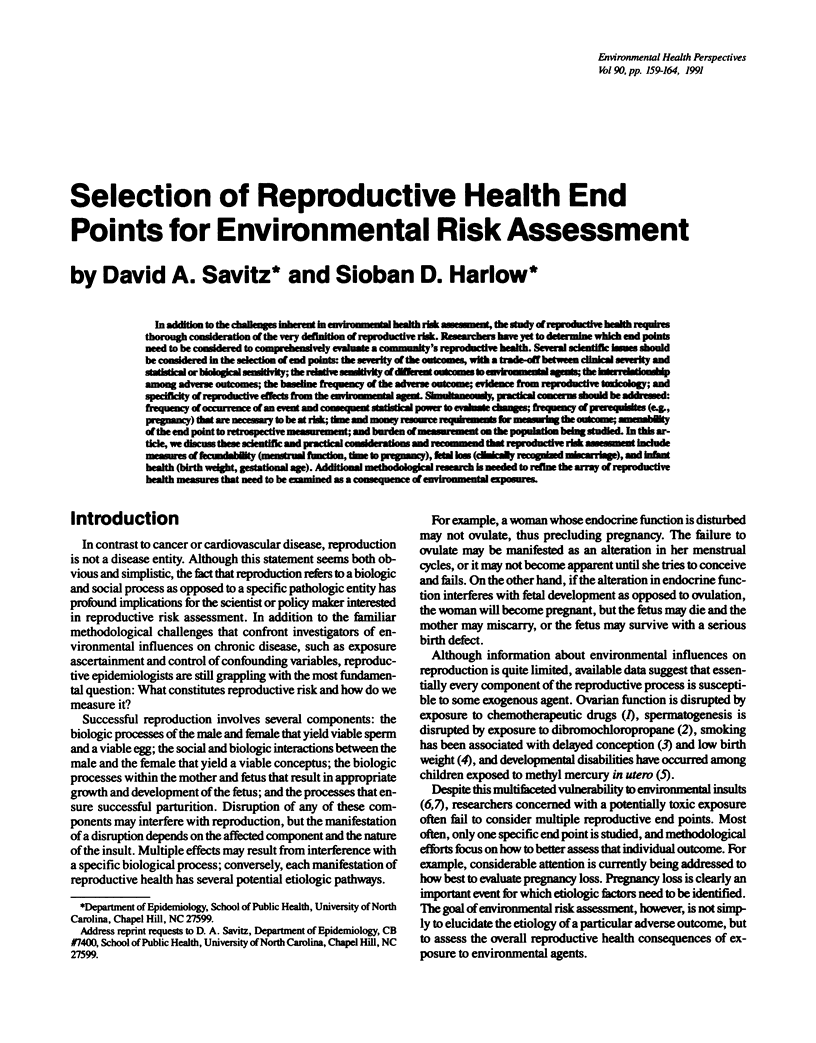
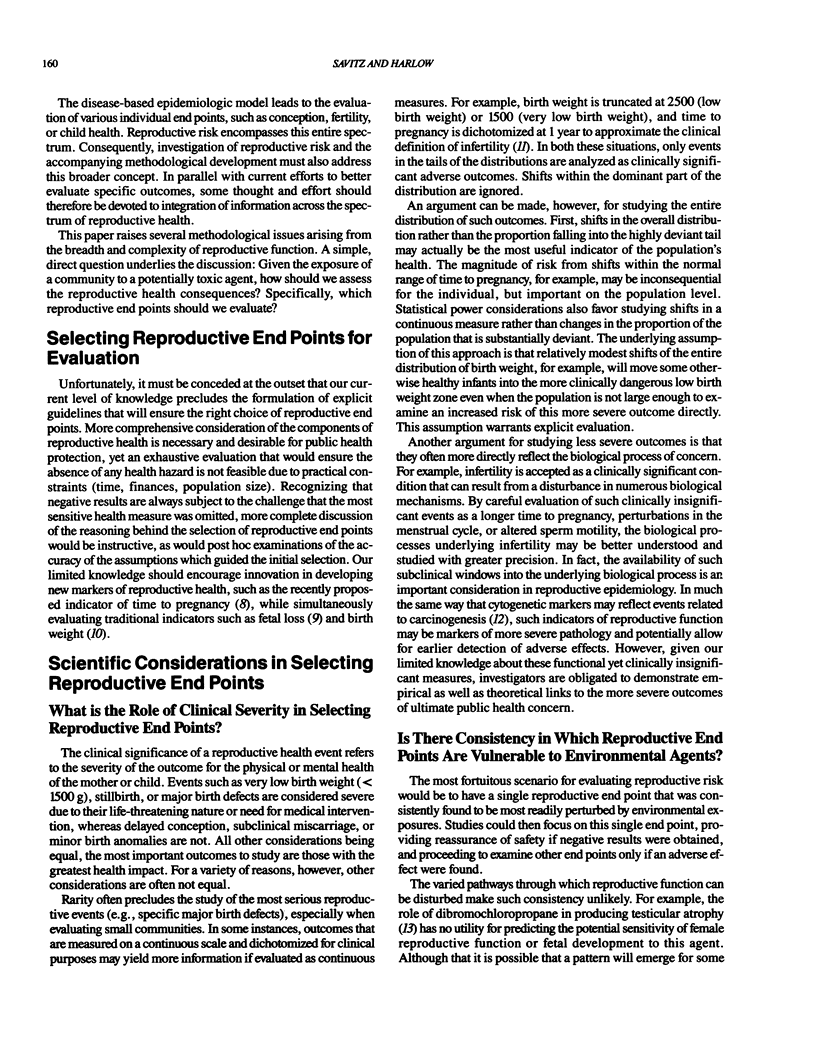
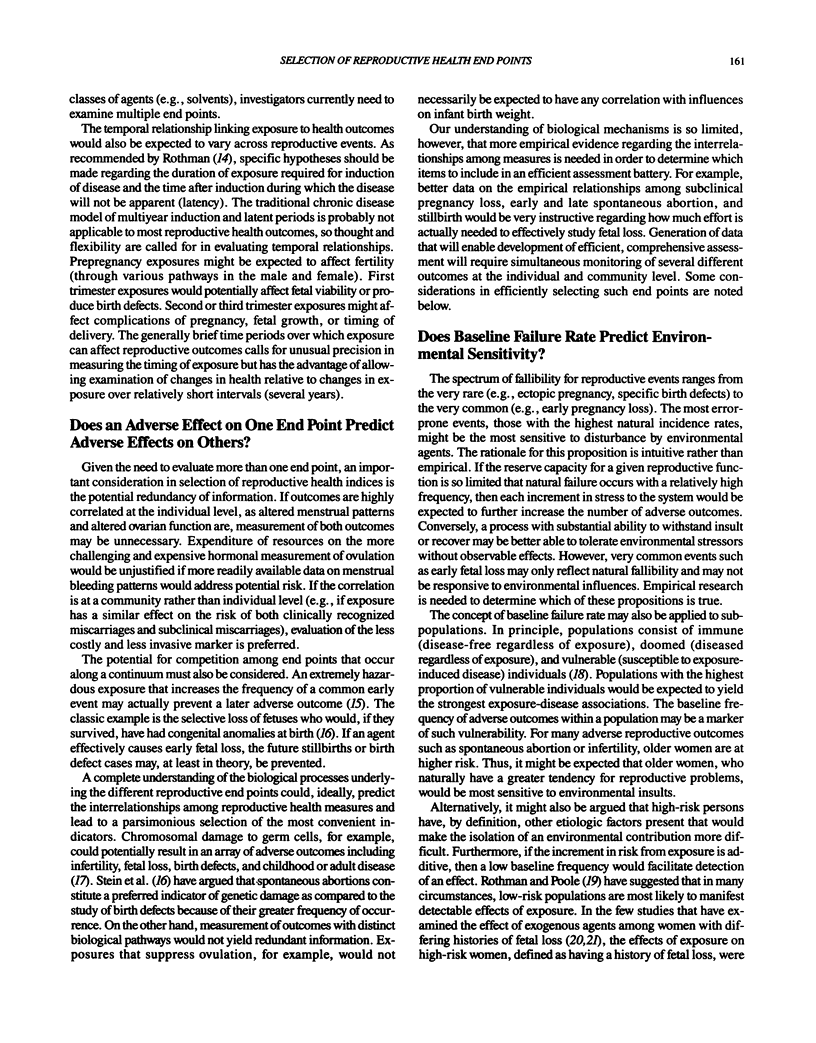
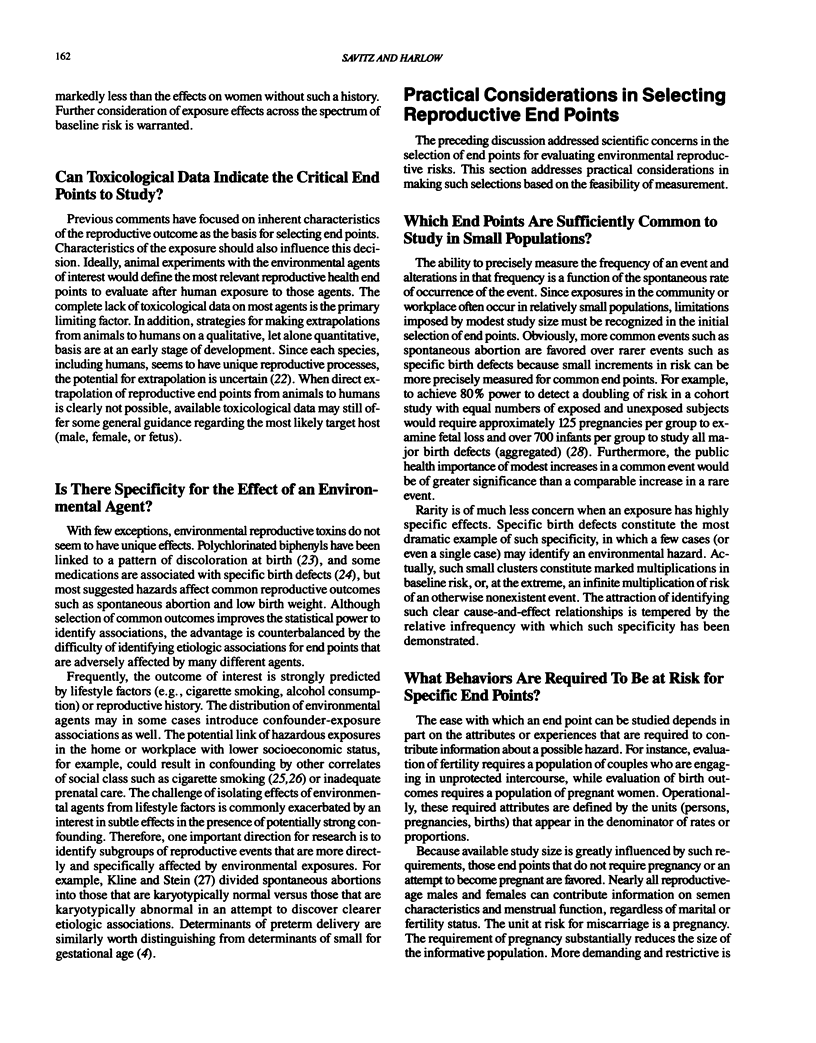
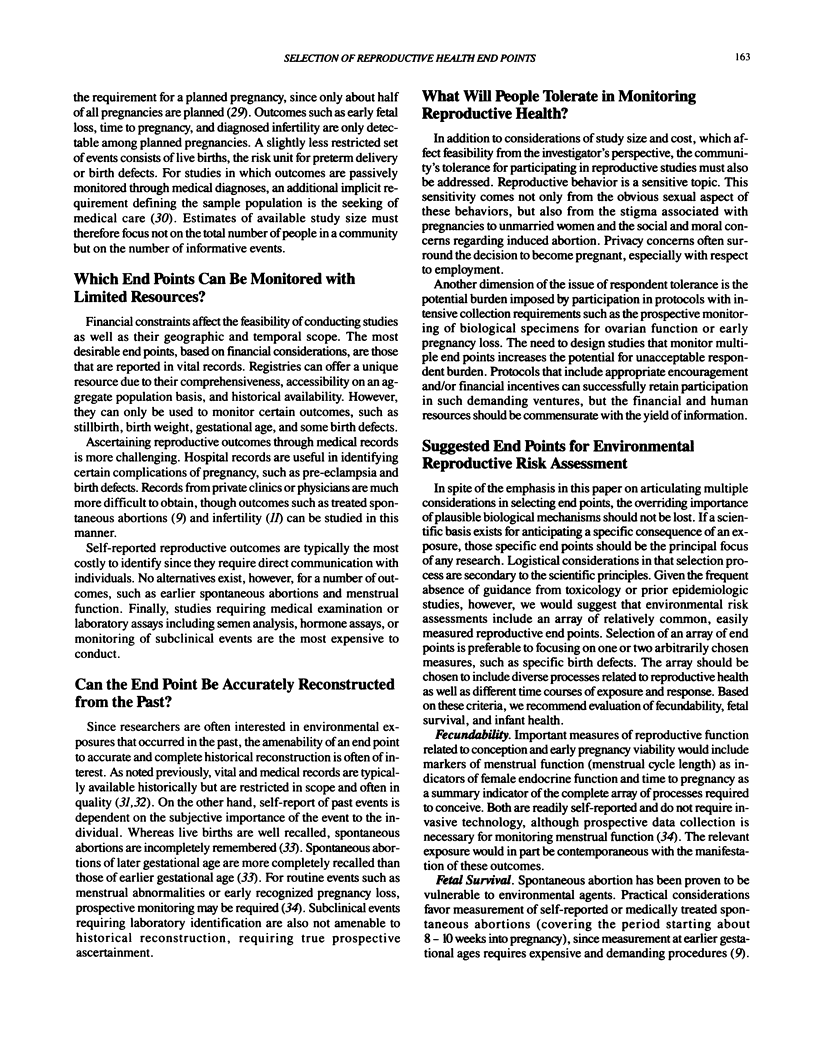
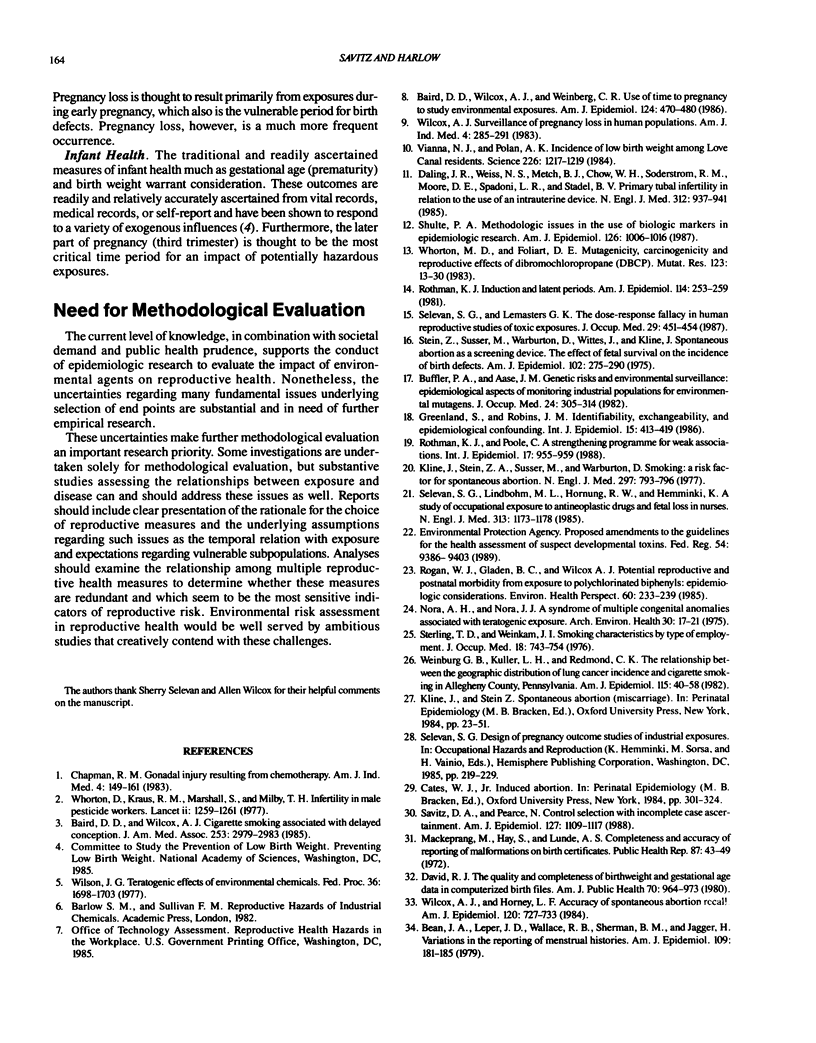
Selected References
These references are in PubMed. This may not be the complete list of references from this article.
- Baird D. D., Wilcox A. J. Cigarette smoking associated with delayed conception. JAMA. 1985 May 24;253(20):2979–2983. [PubMed] [Google Scholar]
- Baird D. D., Wilcox A. J., Weinberg C. R. Use of time to pregnancy to study environmental exposures. Am J Epidemiol. 1986 Sep;124(3):470–480. doi: 10.1093/oxfordjournals.aje.a114417. [DOI] [PubMed] [Google Scholar]
- Bean J. A., Leeper J. D., Wallace R. B., Sherman B. M., Jagger H. Variations in the reporting of menstrual histories. Am J Epidemiol. 1979 Feb;109(2):181–185. doi: 10.1093/oxfordjournals.aje.a112673. [DOI] [PubMed] [Google Scholar]
- Buffler P. A., Aase J. M. Genetic risks and environmental surveillance: epidemiological aspects of monitoring industrial populations for environmental mutagens. J Occup Med. 1982 Apr;24(4):305–314. [PubMed] [Google Scholar]
- Chapman R. M. Gonadal injury resulting from chemotherapy. Am J Ind Med. 1983;4(1-2):149–161. [PubMed] [Google Scholar]
- Daling J. R., Weiss N. S., Metch B. J., Chow W. H., Soderstrom R. M., Moore D. E., Spadoni L. R., Stadel B. V. Primary tubal infertility in relation to the use of an intrauterine device. N Engl J Med. 1985 Apr 11;312(15):937–941. doi: 10.1056/NEJM198504113121501. [DOI] [PubMed] [Google Scholar]
- David R. J. The quality and completeness of birthweight and gestational age data in computerized birth files. Am J Public Health. 1980 Sep;70(9):964–973. doi: 10.2105/ajph.70.9.964. [DOI] [PMC free article] [PubMed] [Google Scholar]
- Greenland S., Robins J. M. Identifiability, exchangeability, and epidemiological confounding. Int J Epidemiol. 1986 Sep;15(3):413–419. doi: 10.1093/ije/15.3.413. [DOI] [PubMed] [Google Scholar]
- Kline J., Stein Z. A., Susser M., Warburton D. Smoking: a risk factor for spontaneous abortion. N Engl J Med. 1977 Oct 13;297(15):793–796. doi: 10.1056/NEJM197710132971501. [DOI] [PubMed] [Google Scholar]
- Mackeprang M., Hay S., Lunde A. S. Completeness and accuracy of reporting of malformations on birth certificates. HSMHA Health Rep. 1972 Jan;87(1):43–49. [PMC free article] [PubMed] [Google Scholar]
- Nora A. H., Nora J. J. A syndrome of multiple congenital anomalies associated with teratogenic exposure. Arch Environ Health. 1975 Jan;30(1):17–21. doi: 10.1080/00039896.1975.10666626. [DOI] [PubMed] [Google Scholar]
- Rogan W. J., Gladen B. C., Wilcox A. J. Potential reproductive and postnatal morbidity from exposure to polychlorinated biphenyls: epidemiologic considerations. Environ Health Perspect. 1985 May;60:233–239. doi: 10.1289/ehp.8560233. [DOI] [PMC free article] [PubMed] [Google Scholar]
- Rothman K. J. Induction and latent periods. Am J Epidemiol. 1981 Aug;114(2):253–259. doi: 10.1093/oxfordjournals.aje.a113189. [DOI] [PubMed] [Google Scholar]
- Rothman K. J., Poole C. A strengthening programme for weak associations. Int J Epidemiol. 1988 Dec;17(4):955–959. doi: 10.1093/ije/17.4.955. [DOI] [PubMed] [Google Scholar]
- Savitz D. A., Pearce N. Control selection with incomplete case ascertainment. Am J Epidemiol. 1988 Jun;127(6):1109–1117. doi: 10.1093/oxfordjournals.aje.a114905. [DOI] [PubMed] [Google Scholar]
- Schulte P. A. Methodologic issues in the use of biologic markers in epidemiologic research. Am J Epidemiol. 1987 Dec;126(6):1006–1016. doi: 10.1093/oxfordjournals.aje.a114740. [DOI] [PubMed] [Google Scholar]
- Selevan S. G., Lemasters G. K. The dose-response fallacy in human reproductive studies of toxic exposures. J Occup Med. 1987 May;29(5):451–454. [PubMed] [Google Scholar]
- Selevan S. G., Lindbohm M. L., Hornung R. W., Hemminki K. A study of occupational exposure to antineoplastic drugs and fetal loss in nurses. N Engl J Med. 1985 Nov 7;313(19):1173–1178. doi: 10.1056/NEJM198511073131901. [DOI] [PubMed] [Google Scholar]
- Stein Z., Susser M., Warburton D., Wittes J., Kline J. Spontaneous abortion as a screening device. The effect of fetal survival on the incidence of birth defects. Am J Epidemiol. 1975 Oct;102(4):275–290. doi: 10.1093/oxfordjournals.aje.a112163. [DOI] [PubMed] [Google Scholar]
- Sterling T. D., Weinkam J. J. Smoking characteristics by type of employment. J Occup Med. 1976 Nov;18(11):743–754. doi: 10.1097/00043764-197611000-00011. [DOI] [PubMed] [Google Scholar]
- Vianna N. J., Polan A. K. Incidence of low birth weight among Love Canal residents. Science. 1984 Dec 7;226(4679):1217–1219. doi: 10.1126/science.6505690. [DOI] [PubMed] [Google Scholar]
- Weinberg G. B., Kuller L. H., Redmond C. K. The relationship between the geographic distribution of lung cancer incidence and cigarette smoking in Allegheny County, Pennsylvania. Am J Epidemiol. 1982 Jan;115(1):40–58. doi: 10.1093/oxfordjournals.aje.a113278. [DOI] [PubMed] [Google Scholar]
- Whorton M. D., Foliart D. E. Mutagenicity, carcinogenicity and reproductive effects of dibromochloropropane (DBCP). Mutat Res. 1983 Sep;123(1):13–30. doi: 10.1016/0165-1110(83)90044-1. [DOI] [PubMed] [Google Scholar]
- Wilcox A. J., Horney L. F. Accuracy of spontaneous abortion recall. Am J Epidemiol. 1984 Nov;120(5):727–733. doi: 10.1093/oxfordjournals.aje.a113940. [DOI] [PubMed] [Google Scholar]
- Wilcox A. J. Surveillance of pregnancy loss in human populations. Am J Ind Med. 1983;4(1-2):285–291. [PubMed] [Google Scholar]
- Wilson J. G. Teratogenic effects of environmental chemicals. Fed Proc. 1977 Apr;36(5):1698–1703. [PubMed] [Google Scholar]


